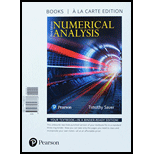
Concept explainers
a.
To find: the best order 2 least squares approximation to the data using the basic function
a.
Explanation of Solution
Given information:
The initial conditions that are given are,
here is the best order 2 least squares approximation to the data using the basic function
Calculation:
As it’s known that by using DFT equation here is the best order 2 least squares approximation to the data using the basic function
According to Theorem 10.11, the order 2 least square approximation results from dropping all but the first two terms in the trigonometric interpolating function
Therefore, the approximating function is
b.
To find: the best order 2 least squares approximation to the data using the basic function
b.
Explanation of Solution
Given information:
The initial conditions that are given are,
here is the best order 2 least squares approximation to the data using the basic function
Calculation:
As it’s known that by using DFT equation, here is the best order 2 least squares approximation to the data using the basic function
.Similar to (a).
Dropping all but the first two terms from the trigonometric interpolating function
c.
To find: the best order 2 least squares approximation to the data using the basic function
c.
Explanation of Solution
Given information:
The initial conditions that are given are, here is the best order 2 least squares approximation to the data using the basic function
Calculation:
As it’s known that by using DFT equation, here is the best order 2 least squares approximation to the data using the basic function
Similar to (a). Dropping all but the first two terms from the trigonometric interpolating function
Want to see more full solutions like this?
Chapter 10 Solutions
Numerical Analysis, Books A La Carte Edition (3rd Edition)
- In simplest way, For each quadratic relation, find the zeros and the maximum or minimum. a) y = x 2 + 16 x + 39 b) y = 5 x2 - 50 x - 120arrow_forwardIn simplest terms and step by step Write each quadratic relation in standard form, then fi nd the zeros. y = - 4( x + 6)2 + 36arrow_forwardIn simplest terms and step by step For each quadratic relation, find the zeros and the maximum or minimum. 1) y = - 2 x2 - 28 x + 64 2) y = 6 x2 + 36 x - 42arrow_forward
- Write each relation in standard form a)y = 5(x + 10)2 + 7 b)y = 9(x - 8)2 - 4arrow_forwardIn simplest form and step by step Write the quadratic relation in standard form, then fi nd the zeros. y = 3(x - 1)2 - 147arrow_forwardStep by step instructions The path of a soccer ball can be modelled by the relation h = - 0.1 d 2 + 0.5 d + 0.6, where h is the ball’s height and d is the horizontal distance from the kicker. a) Find the zeros of the relation.arrow_forward
- In simplest terms, Describe the shape and position of the parabola relative to the graph of y = x 2 y = - 80( x + 9) 2 + 10.8arrow_forwardas a Identify each equation Parabola, circle, ellipse perbola without completio the square. x²-6x-14 y = 33-y² 14y ofarrow_forwardI need the last answer t=? I did got the answer for the first two this is just homework.arrow_forward
- Algebra & Trigonometry with Analytic GeometryAlgebraISBN:9781133382119Author:SwokowskiPublisher:Cengage
 Linear Algebra: A Modern IntroductionAlgebraISBN:9781285463247Author:David PoolePublisher:Cengage Learning
Linear Algebra: A Modern IntroductionAlgebraISBN:9781285463247Author:David PoolePublisher:Cengage Learning Elementary Linear Algebra (MindTap Course List)AlgebraISBN:9781305658004Author:Ron LarsonPublisher:Cengage Learning
Elementary Linear Algebra (MindTap Course List)AlgebraISBN:9781305658004Author:Ron LarsonPublisher:Cengage Learning


